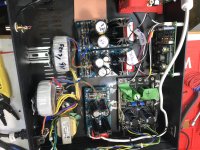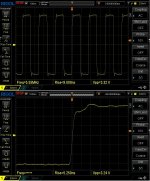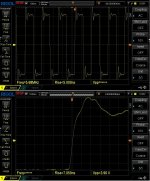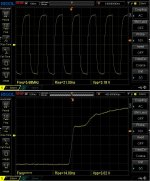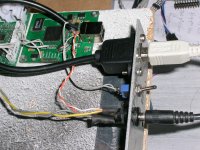I can't tell you much of the technicalities but from the first paragraph of that Isolator manual it galvanically isolates the i2s signals from the Rpi. I just know it made my first implementation of Rpi source improve but also powering the Rpi down the GPIO and not through the mini usb is supposed to help aswell and I did that at the same time. (Powered the Rpi from a Salas L Adapter).
I listen to a wide variety of music...really wide.
Do you actually use those YouTube feeds for music or are they just examples of what you were listening to.? If not what is the source of your streamed music.? I know people will say You tube has no place for music but I find it more than acceptable most of the time.
I listen to a wide variety of music...really wide.
Do you actually use those YouTube feeds for music or are they just examples of what you were listening to.? If not what is the source of your streamed music.? I know people will say You tube has no place for music but I find it more than acceptable most of the time.
I don‘t stream - I tend To find used cds and rip them. Everything is on a 4 tb drive. Im thinking about getting an ADC to digitise my album collection next. The YouTube links are just in case you want to have a listen. i need to do more research on the isolator.
I recently assembled my Marriner dac based on interface guidelines as provided by Richard. This is a very bare bones build since I am awaiting other parts which will allow me to complete the build based on my personal objectives.
Using basic i2s connections from a Raspberry Pi to the Marriner I did some listening tests on some of my go to music for testing new builds. I found that music recorded in the ‘90s (vocals) came out as tiring and instrumental /vocal music recorded in the past 2 years were very pleasant to the ear. This is not an unusual phenomenon for me with my other Rpi based dacs. This also happens when I listen to the Celibidache but not as much. My workaround is to switch to my AK4493S and the PCM switch filter settings to find a happy spot in the ‘90s and older music. All my music is digitized and goes back 70-80 years ago.
My music player is PiCoreplayer software for all my builds and I use Logitech Music server to subtend all the players. My players are built on the Raspberry Pi SBU. Power supplies are linear or shunt regulated depending on the dac. For the Marriner I have a +/- 18V shunt regulated supply running about 100-125 ma total per rail, for the Dac chips I have a dual linear +/- 8V regulated supply and two 5V linear supplies for the Rpi and asynchronous SPDIF to I2s adapter. Control is through the browser on my ios or android.
This was a fun build and thank you.
Using basic i2s connections from a Raspberry Pi to the Marriner I did some listening tests on some of my go to music for testing new builds. I found that music recorded in the ‘90s (vocals) came out as tiring and instrumental /vocal music recorded in the past 2 years were very pleasant to the ear. This is not an unusual phenomenon for me with my other Rpi based dacs. This also happens when I listen to the Celibidache but not as much. My workaround is to switch to my AK4493S and the PCM switch filter settings to find a happy spot in the ‘90s and older music. All my music is digitized and goes back 70-80 years ago.
My music player is PiCoreplayer software for all my builds and I use Logitech Music server to subtend all the players. My players are built on the Raspberry Pi SBU. Power supplies are linear or shunt regulated depending on the dac. For the Marriner I have a +/- 18V shunt regulated supply running about 100-125 ma total per rail, for the Dac chips I have a dual linear +/- 8V regulated supply and two 5V linear supplies for the Rpi and asynchronous SPDIF to I2s adapter. Control is through the browser on my ios or android.
This was a fun build and thank you.
Attachments
Further to my development yesterday, I added a spdif adapter (HifiBerry Digi) to the RPi and then to the asynchronous I2S adapter and to the Marriner. The music sounds fine now and the "tired" artifacts have now gone. Regards.
As I am not interested in running 176/192k I'm currently running my development DACs with a full-speed TE7022 interface (USB->S/PDIF) and this goes through an S/PDIF pulse trafo for isolation. So I didn't think adding a full-speed USB isolator (ADUM3160-based from Taobao, cost about $5) would bring anything else to the party. But in fact it was a subtle improvement, the impression of more richness in the tonal colours.
@jimk04
The blue power supplies are linear voltage regulators from https://glass-ware.stores.yahoo.net/lvregulatorkit.html
The shunts are Salas UltraBib and a search on diyaudio will show you the details for this regulator.
The blue power supplies are linear voltage regulators from https://glass-ware.stores.yahoo.net/lvregulatorkit.html
The shunts are Salas UltraBib and a search on diyaudio will show you the details for this regulator.
Yea, it's odd how USB isolation brings something to the party defying conventional wisdom.As I am not interested in running 176/192k I'm currently running my development DACs with a full-speed TE7022 interface (USB->S/PDIF) and this goes through an S/PDIF pulse trafo for isolation. So I didn't think adding a full-speed USB isolator (ADUM3160-based from Taobao, cost about $5) would bring anything else to the party. But in fact it was a subtle improvement, the impression of more richness in the tonal colours.
I always wondered what it was that caused this improvement - if it was a case of better formed USB signals resulting in less power noise due to less chip processing?
To be honest USB handling of signaling at the electrical level seems to be a specialist area that not many know about but a lot of people with a bit of cursory knowledge about USB have an opinion about.
Glad to see you have an open mind, Richard & the adage "that works in practice, now let's see how it works in theory" seems apt?
Hi John - my initial hypothesis with the improvement from the USB isolator is having two isolations in series improved the isolation overall. Each has a parasitic capacitance so putting them in series lowered the overall capacitance and hence less noise would be able to get through. The AD3160 has about 2pF isolation but overall the isolation of the isolator is determined by the DC/DC converter which I recall has at least 20pF between in and out. So I began to wonder if I could source a DC/DC unit with lower capacitance. I did try two USB isolators in series but didn't notice any further improvement.
I have noticed that my USB connection now seems more fragile than before - its likely its more susceptible to ESD events and a couple of times I've had to unplug and re-plug the USB->S/PDIF box to restore sound.
I have noticed that my USB connection now seems more fragile than before - its likely its more susceptible to ESD events and a couple of times I've had to unplug and re-plug the USB->S/PDIF box to restore sound.
A check of the I2S lines at the DAC input with an oscilloscope may show marginal conditions regarding signal integrityI have noticed that my USB connection now seems more fragile than before
(here BCK line with different cables)
George
Attachments
In an ordinary USB connection, not using an isolator, you can disconnect the ground after the USB handshake has taken place & this maybe shows the effect of full ground isolation. In my experience good USB isolators (particularly ones not using DC-DC conversion) bring some more sonic improvementHi John - my initial hypothesis with the improvement from the USB isolator is having two isolations in series improved the isolation overall. Each has a parasitic capacitance so putting them in series lowered the overall capacitance and hence less noise would be able to get through. The AD3160 has about 2pF isolation but overall the isolation of the isolator is determined by the DC/DC converter which I recall has at least 20pF between in and out. So I began to wonder if I could source a DC/DC unit with lower capacitance. I did try two USB isolators in series but didn't notice any further improvement.
I have noticed that my USB connection now seems more fragile than before - its likely its more susceptible to ESD events and a couple of times I've had to unplug and re-plug the USB->S/PDIF box to restore sound.
Yes, I do believe some consideration should be given to greater signal integrity possibly reducing chip self-induced electrical noise of the USB receiver chips - which aren't simple ?A check of the I2S lines at the DAC input with an oscilloscope may show marginal conditions regarding signal integrity
(here BCK line with different cables)
George
It isn't simple. I am still probing around.which aren't simple
Great info. I will try it and see if communication still works. Thank you.In an ordinary USB connection, not using an isolator, you can disconnect the ground after the USB handshake has taken place & this maybe shows the effect of full ground isolation.
George
Hi merillIn an ordinary USB connection, not using an isolator, you can disconnect the ground after the USB handshake has taken place & this maybe shows the effect of full ground isolation.
I tested your proposal and it works

Thank you very much
George
Attachments
The tricky aspect of removing the GND from the USB is there isn't a way to ensure the common-mode voltage at the USB receiver is kept in check. If the receiver's 0V is connected to mains earth then there won't normally be an issue though as the PC's 0V also goes to mains earth.
Hi Abrax
True. This is always of concern when isolating grounds in a SE audio system, regardless of the way of doing the isolation.
Success or failure is system dependent.
Merill's proposal has the advantage of being simple, almost cost-free and instantly reversible (flip of a switch)
George
True. This is always of concern when isolating grounds in a SE audio system, regardless of the way of doing the isolation.
Success or failure is system dependent.
Merill's proposal has the advantage of being simple, almost cost-free and instantly reversible (flip of a switch)
George
Yes, I know in theory this is the case but in practice it has never failed to work and never caused any damage to USB receiver or sender.The tricky aspect of removing the GND from the USB is there isn't a way to ensure the common-mode voltage at the USB receiver is kept in check. If the receiver's 0V is connected to mains earth then there won't normally be an issue though as the PC's 0V also goes to mains earth.
As George says, it is also possible to do A/B testing on the fly
Yes, it works - any noticeable change in the SQ?Hi merill
I tested your proposal and it works
Thank you very much
George
My experience is that there can be but that actually isolating & reformatting the USB signal brings an additional & greater benefit in SQ
- Home
- Vendor's Bazaar
- Marriner dual PCM56 NOS DAC
